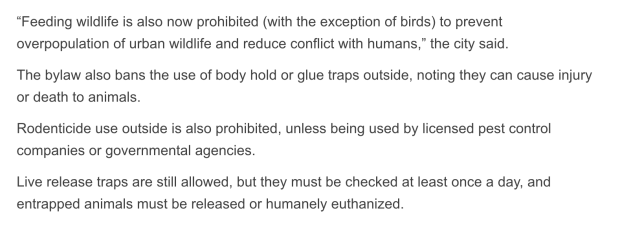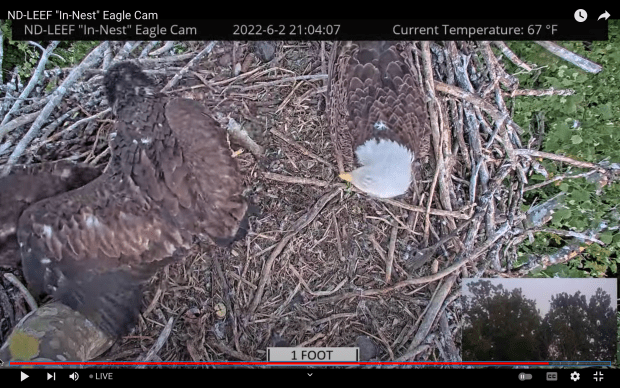23 October 2022
Good Morning Everyone,
As is my usual routine, I am starting my blog for Sunday morning late on Saturday evening. That flu shot has had me a bit under the weather and I have not ventured out to check on the local duck populations. I hope to do that tomorrow with some new images for you. The number of birds in the garden is certainly dwindling. Instead of 40 or more Dark-eyed Juncos there are only a handful and the number of sparrows is about half. The squirrels continue to hoarde the peanuts at the dismay of both the Blue Jays and a single crow. All four of them are in the neighbourhood but, one family has taken to feeding them bread. Crows love bread – it is sweet and salty. It is junk food. And the ones that come to my garden would much rather have bread than healthy nuts, fruit, and protein. Drives me crazy! Angel Wing is why – when we went for a walk around the local duck pond on Thanksgiving, we found two Mallards with Angel Wing. They have since been taken to the wildlife rehab clinic. It is unclear if they will survive. People believe they are helping because the ducks come running for the bread. Sadly, not.
Have you ever heard of Angel Wing? It is a condition in waterfowl caused by a nutritional deficiency. The wings droop or are crooked. The birds cannot fly. It is normally caused by humans feeding bread to the ducks and geese! It can kill them. Feed only high nutrition feed such as wild bird seed OR do not feed them at all.

Making News:
The United Kingdom has been hit particularly hard by Avian Flu. Indeed, scientists now believe that this deadly disease for wild birds and commercial poultry farms will remain in the country year round. The plan is to require anyone who has poultry to move them inside — no more free range eggs or chickens. That is very sad and, well, it is known by Virologists such as Thijs Kuiken -who examines the spread of Avian Flu – that factor farms are the likely cause. I wonder if what is being done in the UK will spread to other European countries?
The finalists in the funniest wildlife shots of the year:

Do you like Chimney Swifts? Have you ever gone birding in Central Park? Are you wondering what the 33 year old Pale Male, the resident Red-tail Hawk of 927 Fifth Avenue is doing? (Yes, he really is 33. He hatched in 1990 and has his own Wikipedia page!). I urge you to check out the blog of Bruce Yolton. Yolton is an excellent wildlife photographer and knows Central Park and its surrounding area as if it were his own hand. He has recently changed his blog template and it is easy to search using the box on the right. There are recent YouTube videos of the swifts as well as one of Pale Male from the 1st of September. Yes, he is still alive. Just do a search using Pale Male on Yolton’s site to see the latest video.
Urbanhawks.com
‘H’ wrote and said she had just watched the film about Pale Male. With all that has gone on at PLO, it is sometimes easy to forget what brings one happiness. So, if you haven’t seen it or if you are like me and you need to watch something that clearly demonstrates just how people can influence a hawk’s life, check it out. It’s free and it is very heart warming and uplifting.
thelegendofpalemale.net
LGK (Lime-Green-Black) is one of the favourite male Albatrosses and is the father of Taiki, last year’s Royal Cam chick. LGK has returned to Taiaroa Head! Here is the announcement by Sharon Dunne:

Damon and Gabby continue to work on restorations on their nest. Just look at the huge stick Samson brought in!
Harriet and M15 continue to work on their nest and rebounding.
Nest News:
The eyases at 367 Collins Street are simply having a fabulous time wandering up and down the gutter. It seems to cause some confusion in the adults still but everyone is coping well. Mum loves her perch and as ‘A’ notes, the pair of them don’t seem to fully understand their duties so both are hunting and bringing prey. I love it – cooperative parenting. In fact, Osprey Mums often start hunting when the ospreys turn 30 days. It really helps during then and fledge when more prey is required.
The Melbourne Four were fed 5 times yesterday. In fact, five seems to be the average feeding per day. I have not sat down to compare delivery times. Once I tracked a hawk family that delivered prey 7 times a day at almost the exact same times. It was like they had a food supply delivery! The four ate at 0628 for 20 minutes, then again at 1108 for 7 minutes (a snack), at 1209 for 22 minutes, at 1540 for 17 minutes and their last meal at 1915 for 16 minutes. Mum continues to perch above the scrape box.
This adorable video of Diamond feeding little Rubus and Indigo popped up on my screen. It is now 6 days old but, it just shows hot cute these two eyases are and how much they have changed. Indigo was a cotton ball then. Poor Little Rubus. I wondered if he would ever get any feathers. Rubus is quite the character, full of vinegar and mischief with as loud a voice as his brother, Izzy. ‘A’ says he is as loud as Yurruga, too!!! It is hard to imagine how much they have grown in 5 days. Just look. They are all white down with no pin feathers.
Meals are coming in on a regular basis for Indigo and Rubus. The pair of them are a delight. Like any younger sibling, Rubus wants to do everything that Indigo does. He has now migrated over to Cilla’s stones to stay with Indigo! And he is enjoying the camera.

The weather appears to not be so good at Port Lincoln. It is now 1439 and I have not seen a fish arrive on the nest since the large breakfast fish. It is entirely possible that Dad has not been able to catch anything. There is an image of Mum eating a fish by herself at 2016 (the clock on the camera is incorrect). She is the one that I worry about. She needs to eat – a bite for Big, one for Middle, and then one for Mum. That would be good! She does not require as much prey as Dad as he is actively fishing but, she has been out fishing and will probably continue to do so to supplement the takings.

If you have been watching the Port Lincoln nest and noted more deliveries to the ospreys on Sunday in Australia (when they wake up it will be Monday), please do let me know.
The cam operator did some really good close ups of the ospreys yesterday. You can see how their feathers are developing and once again, we get a look at those gorgeous amber eyes.



Migration:
We have been following the Black Stork family of Karl II from Estonia to their winter homes in the central part of Africa. There has been no recent transmission from the female, Kaia. Her last transmission was from Chad on the 16th of October. There has been no news from Karl II. His last transmission was from Egypt on the 18th of October. It is likely that both of the adults form the Karla National Forest nest are out of range for transmissions. The two fledglings with satellite transmitters are Bonus and Waba. Waba flew 161 km and is now in Turkey near Antalya along the coast.

Bonus flew 106 km and is near the village of Gravita in Romania.

Thank you so much for being with me this morning. Wish for fish at Port Lincoln. All is well at the other nests. The Bald Eagles are busy building and there is word that an artificial nest might go up for Connie and Clive at Captiva as the trees are mostly destroyed – the ones good for Eagles. Take care everyone – see you soon! Please note that my check on breakfast feedings in Australia will be coming out late. Just wanted to let you know.
Thank you to the following for their posts, videos, and streaming cams where I took my screen captures: Sharon Dunne aka Lady Hawk videos, SWFlorida and D Pritchett, AEF-NEFL, Looduskalender, Port Lincoln Ospreys, 367 Collins Street by Mirvac, BBC, Royal Albatross FB Group, and Charles Stuart Falcon Cam.






































































































































































